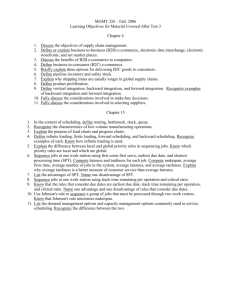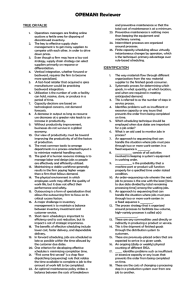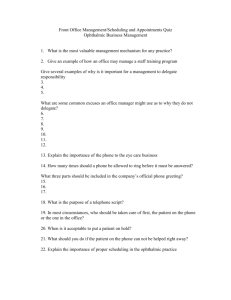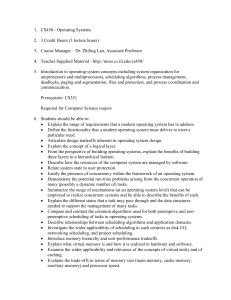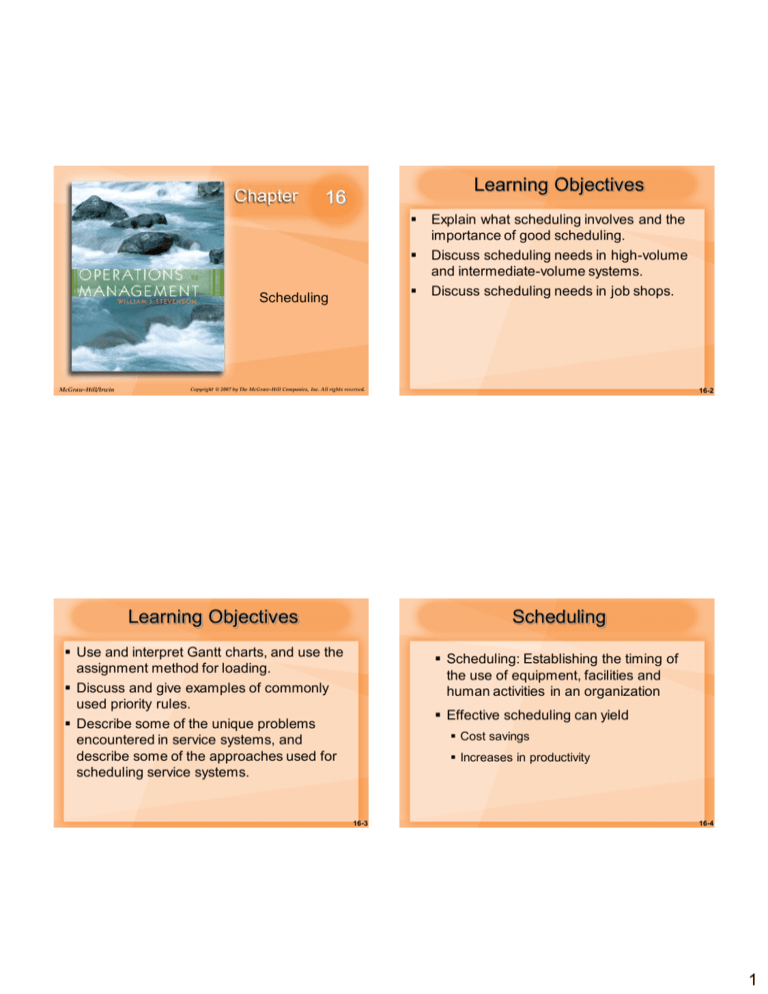
Learning Objectives
16
Scheduling
McGraw-Hill/Irwin
Explain what scheduling involves and the
importance of good scheduling.
Discuss scheduling needs in high-volume
and intermediate-volume systems.
Discuss scheduling needs in job shops.
Copyright © 2007 by The McGraw-Hill Companies, Inc. All rights reserved.
16-2
Scheduling
Learning Objectives
Use and interpret Gantt charts, and use the
assignment method for loading.
Discuss and give examples of commonly
used priority rules.
Describe some of the unique problems
encountered in service systems, and
describe some of the approaches used for
scheduling service systems.
Scheduling: Establishing the timing of
the use of equipment, facilities and
human activities in an organization
Effective scheduling can yield
Cost savings
Increases in productivity
16-3
16-4
1
High-Volume Success Factors
High-Volume Systems
Process and product design
Flow system: High-volume system with
Standardized equipment and activities
Preventive maintenance
Flow-shop scheduling: Scheduling for high-
Rapid repair when breakdown occurs
volume flow system
Optimal product mixes
Work Center #1
Work Center #2
Minimization of quality problems
Output
Reliability and timing of supplies
16-5
Intermediate-Volume Systems
Scheduling Low-Volume Systems
Outputs are between standardized highvolume systems and made-to-order job
shops
Loading - assignment of jobs to
process centers
Sequencing - determining the order
in which jobs will be processed
Job-shop scheduling
Run size, timing, and sequence of jobs
Economic run size:
Q0
16-7
Scheduling for low-volume
systems with many
variations
in requirements
2DS
p
H p u
16-8
16-9
2
Loading
Gantt Load Chart
Figure 16.2
Infinite loading – jobs are assigned to
work centers without regard for the
capacity of the work center.
Gantt chart - used as a visual aid for
loading and scheduling
Work Mon. Tues. Wed. Thurs. Fri.
Center
1
Job 3
Job 4
2
Job 3 Job 7
3
Job 1
Job 6
Job 7
4
Job 10
Finite loading – jobs are assigned to
work centers taking into account the
work center capacity and job processing
times
16-10
16-11
Assignment Method of linear
programming
Loading (cont’d)
Forward scheduling – scheduling ahead from some point in
time.
Backward scheduling – scheduling by working backwards in
time from the due date(s).
Schedule chart – a form of Gantt chart that shows the
orders or jobs in progress and whether they are on
schedule.
The assignment model is a special-purpose linear
programming model that is useful in situations that call for
assigning tasks or other work requirements to resources.
Typical examples include assigning
jobs to machines or workers,
territories to salespeople, and
repair jobs to repair crews.
The idea is to obtain an optimum matching of tasks and
resources.
16-12
16-13
3
Example 1
Example 1
Determine the optimum assignment of jobs to
machines for the following data :
a. Subtract the smallest number in each row from
every number in the row, and enter the results
in a new table. The result of this row reduction
is
b. Subtract the smallest number in each column
from every number in the column, and enter
the results in a new table. The result of this
column reduction is
c. Determine the minimum number of lines
needed to cross out all zeros. (Try to cross out
as many zeros as possible when drawing
lines.)
16-14
Example 1
d.
Since only three lines are needed to cross out all zeros
and the table has four rows, this is not the optimum. Note
that the smallest uncovered value is 1.
e.
Subtract the smallest uncovered value from every
uncovered number that hasn’t been crossed out, and add
it to numbers that are at the intersections of covering
lines. The results are as follows:
f.
Determine the minimum number of lines needed to cross
out all zeros (four). Since this equals the number of rows,
you can make the optimum assignment.
g.
16-15
Sequencing
Sequencing: Determine the order in
which jobs at a work center will be
processed.
Workstation: An area where one person
works, usually with special equipment,
on a specialized job.
Make assignments: Start with rows and columns with
only one zero. Match jobs with machines that have a
zero cost.
16-16
16-17
4
Sequencing
Priority Rules
Table 16.2
FCFS - first come, first served
Priority rules: Simple heuristics
used to select the order in
which jobs will be processed.
SPT
- shortest processing time
EDD - earliest due date
Everything is
#1 Priority
CR - critical ratio
Job time: Time needed for
setup and processing of a job.
S/O - slack per operation
Rush - emergency
Top Priority
16-18
16-19
Assumptions of Priority Rules
Performance Measures
Job flow time.
The setup of jobs is known
Setup time is independent of processing
sequence
Setup time is deterministic
There will be no interruptions in processing
such as:
This is the length of time a job is at a particular workstation or work
center.
It includes not only actual processing time but also any time waiting
to be processed, transportation time between operations, and any
waiting time related to equipment breakdowns, unavailable parts,
quality problems, and so on.
Job lateness. (tardiness)
This is the length of time the job completion date is expected to
exceed the date the job was due or promised to a customer.
Makespan.
Machine breakdowns
Accidents
Worker illness
Makespan is the total time needed to complete a group of jobs.
Average number of jobs.
Jobs that are in a shop are considered to be work-in-process inventory.
Average number of jobs = Total flow time ÷ Makespan
16-20
16-21
5
Example 2-a) FCFS
Example 2
Processing times (including setup times) and due dates for six jobs
waiting to be processed at a work center are given in the following
table.
Determine
• the sequence of jobs,
• the average flow time,
• average tardiness, and
• average number of jobs at the work center,
for each of these rules:
a. FCFS
Job Processing Due Dates
b. SPT
Time (days)
(days)
c. EDD
A
2
7
d. CR
B
Assume jobs arrived in the order shown.
8
The FCFS sequence is simply A-B-C-D-E-F. The measures of effectiveness are
as follows (see table):
Job
(1)
Processing
Time
4
4
D
10
17
E
5
15
F
12
18
(2) - (3)
Days Tardy [0 if
negative]
0
A
2
2
7
8
10
16
0
C
4
14
4
10
D
10
24
17
7
E
5
29
15
14
F
12
41
18
23
41
(3)
Due Dates
B
16
C
(2)
Flow Time
54
120
Average flow time: 120÷6 = 20 days.
Average tardiness: 54÷6 = 9 days.
The makespan is 41 days.
Average number of jobs at the work center: 120÷41 = 2.93.
16-22
16-23
Example 2-b) SPT
The FCFS sequence is simply A-B-C-D-E-F. The measures of effectiveness are
as follows (see table):
The FCFS sequence is simply A-B-C-D-E-F. The measures of effectiveness are
as follows (see table):
Job
(1)
Processing
Time
(2)
Flow Time
(3)
Due Dates
(2) - (3)
Days Tardy [0 if
negative]
Job
(1)
Processing
Time
(2)
Flow Time
(3)
Due Dates
(2) - (3)
Days Tardy [0 if
negative]
A
2
2
7
0
C
4
4
4
0
C
4
6
4
2
A
2
6
7
0
E
5
11
15
0
E
5
11
15
0
B
8
19
16
3
B
8
19
16
3
D
10
29
17
12
D
10
29
17
12
F
12
41
18
23
F
12
41
18
23
41
Example 2-c) EDD
108
40
41
Average flow time: 108÷6 = 18 days.
Average tardiness: 40÷6 = 6.67 days.
The makespan is 41 days.
Average number of jobs at the work center: 108÷41 = 2.63.
16-24
110
38
Average flow time: 110÷6 = 18.33 days.
Average tardiness: 38÷6 = 6.33 days.
The makespan is 41 days.
Average number of jobs at the work center: 110÷41 = 2.68.
16-25
6
Example 2-d) Critical Ratio
Using the critical ratio we find
Job
Example 2-d) Critical Ratio
Processing
Time
Due
Dates
Critical Ratio
Calculation
A
2
7
(7-0)/2 = 3.5
B
8
16
(16-0)/8 = 2.0
C
4
4
(4-0)/4 = 1.0
D
10
17
(17-0)/10 = 1.7
E
5
15
(15-0)/5 = 3.0
F
12
18
(18-0)/12 =1.5
C
At day 16 [C and F completed], the critical ratios are
Job
Processing
Time
Due
Dates
Critical Ratio
Calculation
A
2
7
(7-16)/2 = -4.5
B
8
16
(16-16)/8 = 0
D
10
17
(17-16)/10 = 0.1
E
5
15
(15-16)/5 = -0.2
Job
Processing
Time
Due
Dates
Critical Ratio
Calculation
B
8
16
(16-18)/8 = -0.25
Job
Processing
Time
Due
Dates
Critical Ratio
Calculation
D
10
17
(17-18)/10 = -0.1
A
2
7
(7-4)/2 = 1.5
E
5
15
(15-18)/5 = -0.6
B
8
16
(16-4)/8 = 1.5
D
10
17
(17-4)/10 = 1.3
E
5
15
(15-4)/5 = 2.2
12
18
(18-4)/12 =1.17
F
A
At day 18 [C,F and A completed], the critical ratios are
At day 4 [C completed], the critical ratio are
F
C
C
F
A E
At day 23 [C ,F,A, and E completed], the critical ratios are
C
F
16-26
Job
Processing
Time
Due
Dates
Critical Ratio
Calculation
B
8
16
(16-23)/8 = -0.875
D
10
17
(17-23)/10 = -0.6
Example 2-d) Critical ratio
C
F
A E
B
D
16-27
Example 2
Table 16.4
The FCFS sequence is simply A-B-C-D-E-F. The measures of effectiveness are
as follows (see table):
Job
(1)
Processing
Time
(3)
Due Dates
(2) - (3)
Days Tardy [0 if
negative]
C
4
4
4
0
F
12
16
18
0
A
2
18
7
11
E
5
23
15
8
B
8
31
16
15
D
10
41
17
24
41
(2)
Flow Time
133
Rule
Average
Flow Time
(days)
Average
Tardiness
(days)
Average
Number of
Jobs at the
Work Center
FCFS
20.00
9.00
2.93
SPT
18.00
6.67
2.63
EDD
18.33
6.33
2.68
CR
22.17
9.67
3.24
58
Average flow time: 133÷6 = 22.17 days.
Average tardiness: 58÷6 = 9.67 days.
Average number of jobs at the work center: 133÷41 = 3.24.
16-28
16-29
7
Example 3
Example 3- Solution
Use the S/O rule to schedule the following jobs. Note that processing time
includes the time remaining for the current and subsequent operations. In
addition, you will need to know the number of operations remaining, including the
current one.
Job
Processing
Time (days)
Due Dates
(days)
Remaining
number of
operations
A
4
14
3
B
16
32
6
C
8
8
5
D
20
34
2
E
10
30
4
F
18
30
2
Determine the difference between the due date and the processing time for each
operation. Divide the difference by the number of remaining operations, and rank
them from low to high. This yields the sequence of jobs:
Job
(1)
(2)
Remaining Due Date
Processing
Time
(3)
(2)-(1)
Slack
(4)
Remaining
Number of
Operations
(5)
(3)/(4)
Ratio
(6)
Rank
A
4
14
10
3
3.33
3
B
16
32
16
6
2.67
2
C
8
8
0
5
0
1
D
20
34
14
2
7.00
6
E
10
30
20
4
5.00
4
F
18
30
12
2
6.00
5
16-30
16-31
Johnson’s Rule Conditions
Two Work Center Sequencing
Johnson’s Rule: technique for minimizing
Job time must be known and constant
completion time for a group of jobs to be
processed on two machines or at two work
centers.
Job times must be independent of
sequence
Minimizes total idle time
Jobs must follow same two-step
sequence
Several conditions must be satisfied
Job priorities cannot be used
All units must be completed at the
first
work center before moving to second
16-32
16-33
8
Johnson’s Rule Optimum
Sequence
Scheduling Difficulties
Variability in
1.List the jobs and their times at each work
center
2.Select the job with the shortest time
3.Eliminate the job from further
consideration
4.Repeat steps 2 and 3 until all jobs have
been scheduled
Setup times
Processing times
Interruptions
Changes in the set of jobs
No method for identifying optimal schedule
Scheduling is not an exact science
Ongoing task for a manager
16-34
16-35
Example 4
Example 4- Solution
A group of six jobs is to be processed through a two-machine flow shop. The first
operation involves cleaning and the second involves painting. Determine a
sequence that will minimize the total completion time for this group of jobs.
Processing times are as follows:
1st
Processing Time (Hours)
Job
Work Center 1
Work Center 2
A
5
5
B
4
3
C
8
9
D
2
a. Select the job with the shortest processing time. It is job
D, with a time of two hours.
b. Since the time is at the first center, schedule job D first.
Eliminate job D from further consideration.
2nd
3rd
4th
5th
6th
D
c. Job B has the next shortest time. Since it is at the
second work center, schedule it last and eliminate job B
from further consideration. We now have
7
E
6
8
1st
F
12
15
D
16-36
2nd
3rd
4th
5th
6th
B
t
Job
C1
C2
A
5
5
C
8
9
D
2
7
E
6
8
F
12
15
Job
C1
C2
t
A
5
5
B
4
3
C
8
9
E
6
8
F
12
15
16-37
9
Example 4- Solution
Example 4- Solution
d. The remaining jobs and their times are
1st
2nd
3rd
4th
D
5th
6th
A
B
e. The shortest remaining time is six hours for job E at
work center 1. Thus, schedule that job toward the
beginning of the sequence (after job D). Thus,
1st
2nd
D
E
3rd
4th
5th
6th
A
B
f. Job C has the shortest time of the remaining two jobs. Since it is for the first
work center, place it third in the sequence. Finally, assign the remaining job
(F) to the fourth position and the result is
t
Job
C1
C2
A
5
5
C
8
9
E
6
8
F
12
15
Note that there is a tie for the shortest remaining time:
job A has the same time at each work center. It makes
no difference, then, whether we place it toward the
beginning or the end of the sequence. Suppose it is
placed arbitrarily toward the end. We now have
t
1st
D
2nd
E
3rd
C
4th
F
5th
A
6th
B
Job
C1
C
8
9
F
12
C2
15
g. One way to determine the throughput time and idle times at the work centers
is to construct a chart:
t
Job
C1
C2
C
8
9
E
6
8
F
12
15
16-38
16-39
Theory of Constraints
Minimizing Scheduling Difficulties
Set realistic due dates
The Theory of Constraints Goal is to
maximize flow through the entire system
Emphasizes balancing flow
Improve performance of bottleneck:
Focus on bottleneck operations
Consider lot splitting of large jobs
16-40
Determine what is constraining the operation
Exploit the constraint
Subordinate everything to the constraint
Determine how to overcome the constraint
Repeat the process for the next constraint
16-41
10
Scheduling Services
Considerations
Scheduling Services
Appointment systems
Scheduling services different from
manufacturing
Inability to store or inventory services
Random nature of customer requests for service
Point of customer contact
Controls customer arrivals for service
Reservation systems
Estimates demand for service
Scheduling the workforce
Back-office operations
Front-office operations
Manages capacity for service
Scheduling multiple resources
Coordinates use of more than one
resource
16-43
16-44
Yield Management
Cyclical Scheduling
Yield Management – the application of
pricing strategies to allocate capacity among
various categories of demand.
The goal is to maximize the revenue
generated by the fixed capacity
Fixed capacity
Hotel, motel rooms
Airline seats
Hospitals, police/fire departments,
restaurants, supermarkets
Rotating schedules
Set a scheduling horizon
Identify the work pattern
Develop a basic employee schedule
Assign employees to the schedule
Unsold rooms or seats cannot be carried
over
16-45
16-46
11



